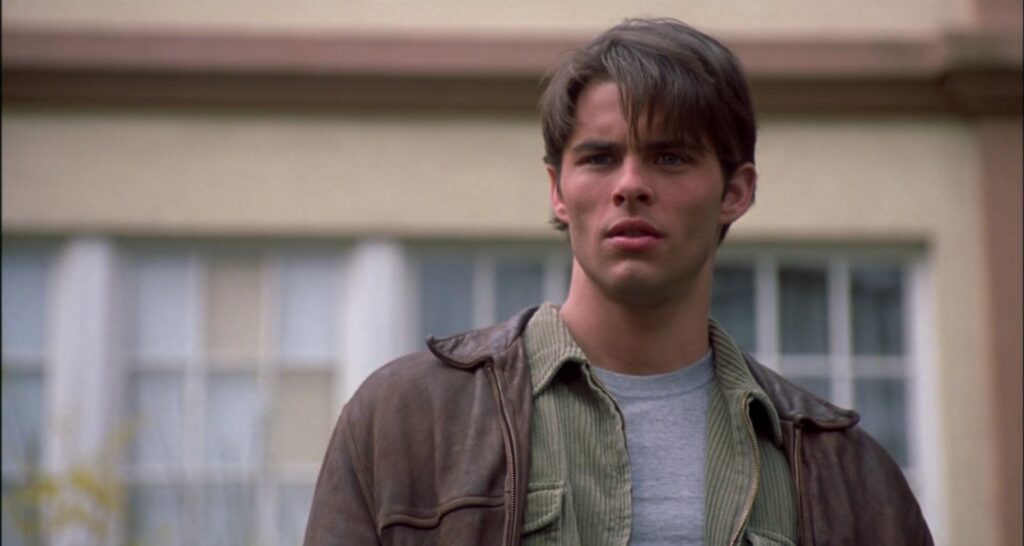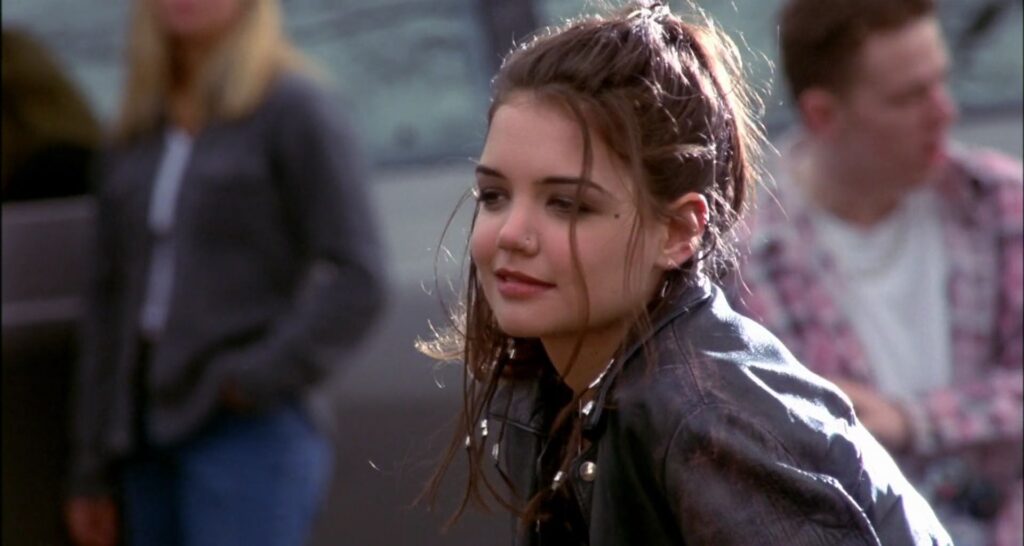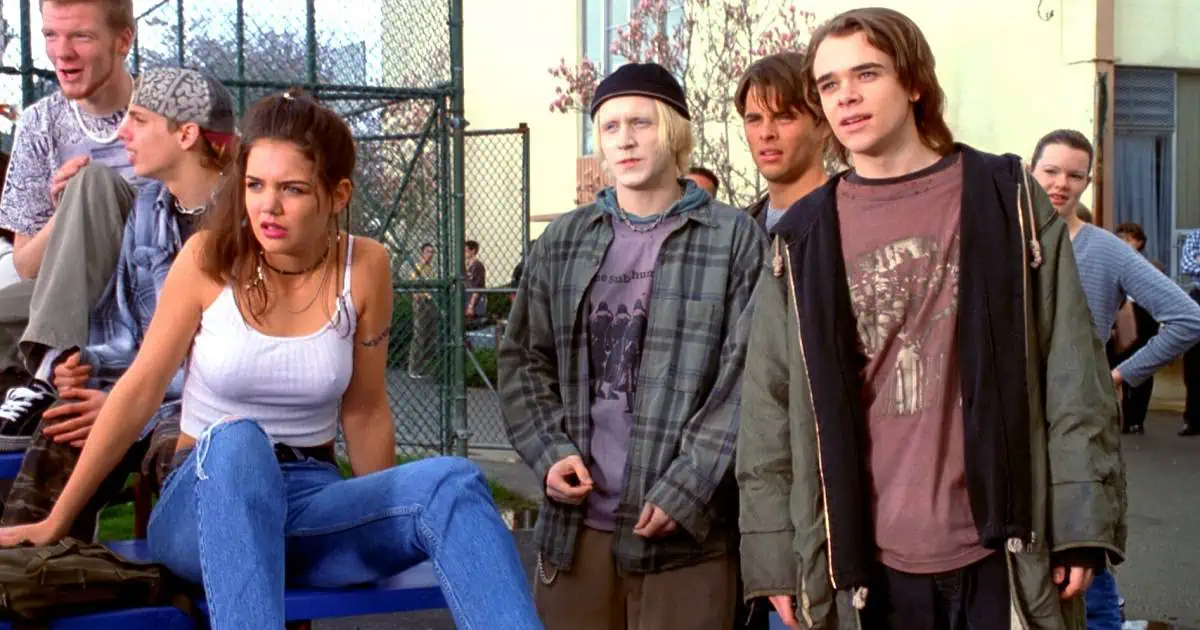Freaks all week
Every October, in the guts of spooky season, I try to catch at least one post-Scream, back-to-school teen horror film from the late ‘90s or early ‘00s. This year, I opted for 1998’s Disturbing Behavior, a movie whose title promises something transgressive but delivers an extra-polished episode of The X-Files. Incidentally, the director is David Nutter, a veteran director of episodes of The X-Files.
The film opens with one of its best scenes, a cliff-side make-out fake-out that subverts its narrative expectations three times in three minutes. Although the scene throws suspicion on the cops, a femme fatale, and a scruffy peeping Tom Gavin (Nick Stahl), the ultimate villain of the scene is a member of the fresh-cuts in the letterman jackets, a clique called “The Blue Ribbons.” The film takes place in Cradle Bay, a Pacific Northwest town, shown through the eyes of new kid and city transplant Steve Clark (James Marsden). Steve falls in with Gavin, a paranoid stoner who gives him a speed-run tour of the high school social order and then insists in a conspiratorial ramble that the Blue Ribbons aren’t just a gang of preps; they’re pod people. Hovering in Steve’s orbit is Rachel (Katie Holmes), a leather-jacket, midriff-baring rebel who says “razor” instead of “cool,” which is, frankly, razor. The adults in the school follow the lead of charismatic therapist and counselor Dr. Edgar Caldicott (Bruce Greenwood), who is also a bigwig at the PTA.

If you’ve seen The Faculty, you’ll recognize the shape of Disturbing Behavior, as the two movies bear a striking resemblance and came out in the same year: both examine high-school conformity as a mind-control invasion thriller. But where Robert Rodriguez serves up slick visuals, aliens, goo, and sexy teachers, Nutter, a prolific TV director, cuts down on effects and renders the affair a bit more psychological. The Blue Ribbons get outed as a sort of conversion therapy for misfits: parents sign their kids up to be “fixed,” and before long, they turn into Stepford teens via some secret brainwashing operation. The effect successfully turns teens into rule-followers until hormones overload the circuit and trigger blasts of violence by the teens. Thus, the Blue Ribbon-ification process is a metaphor for conformity. Repression of both unwelcome urges and distinct personality traits is the root of the danger.
Conspicuously, The Blue Ribbons, and Cradle Bay in general, are entirely non-religious. Maybe screenwriter Scott Rosenberg wrote it this way to minimize controversy, or maybe he wanted to speak more broadly to culture than specifically to over-religiosity. Regardless, I found it easy to imagine Dr. Calidicott as a fundamentalist reverend and the Blue Ribbons as an FCA youth group.
Nutter’s TV pedigree is both a feature and a bug. At its best, the film feels like a sharply blocked, handsomely lit episode of ‘90s cable TV: legible nighttime action, crisp silhouettes, clear spatial geometry. And yet Nutter’s instincts are less cinematic and more conventional: the film practically feels like it’s missing commercial breaks, built less around set pieces, images or mood (normal horror bread and butter) than light suspense and functional storytelling, which makes it more of a light sci-fi thriller than a horror movie proper. The pacing is tetchy, which is a byproduct of mangled studio interference following some poor test screenings: editor Randy Jon Morgan hacked the runtime from nearly two hours down to 82 minutes, and you can feel the scissors especially in the character work. Steve’s family trauma, depicted here as a generic “my brother died and so I’m sad,” initially had a richer Romeo & Juliet-adjacent backstory that would’ve given his anti-conformity stance real teeth and offered echoes to his own fate. Rachel has hints of “I’m stuck in this town” longing, but the film cuts short her blossoming connection with Steve. Even the ending is mangled: the studio requested a jokey stinger that makes no sense and undercuts the more melancholy finish this story is angling for. The much better original ending scene reunited Steve, Rachel, and Gavin in heartbreaking fashion. (Much of this extra material is preserved in deleted scenes found on the Blu-ray or on Youtube. If you hunt around online, you can find a fan-made extended cut cobbled together with the deleted scenes.)

Still, the trio at the center gives Disturbing Behavior a pulse. Marsden is a great straight-man anchor. He plays an outsider, which runs against his princely presence of square-jawed decency. Holmes’ baby-faced smirk is endearing and expressive, but she also flat-out acts, always offering more depth and sadness than the script really offers her (at least in the theatrical cut). Stahl gets the most interesting material to work with and thus delivers the most fun performance. His Gavin goes to extreme places, from class clown to tweaking paranoid to brainwashed goon, and the movie really benefits when he’s onscreen. Greenwood, meanwhile, as the villain plays Caldicott a little bit lower key than I would have suggested, leaving not much room for derangement, instead opting for cold danger. If Disturbing Behavior has a single, clean thesis, it’s that fear of the messiness of diversity and free-spiritedness curdles into authoritarian oppression awfully fast.
The film’s craft is a mixed bag. The photography is rich and vibrant in a way that we could usually take for granted in Hollywood productions until digital photography became cheap and easy circa the mid-2000s, and Nutter stages a few set-pieces with real snap (the cafeteria reveal of Gavin’s heel turn is memorable). I’m much lower on the sound, especially Mark Snow’s score, which is all tinkly pseudo-Tubular Bells, like a TV temp track that never got upgraded. The needle-drops are very ’98, but a lower-end cross-section of the era. Then again, we get to hear a verse of Harvey Danger’s “Flagpole Sitta,” which makes up for most of the other musical sins.

Compared to other Scream-likes, this one registers a little lower on the fun and charm scale, but not dangerously so. It has no flavor that really pops like Idle Hands’ splattery slapstick or The Craft’s vibe of sisterhood. And I’d put it a notch below its most obvious peer, The Faculty, which has a deeper bench of actors and gnarlier payoffs. But I don’t think “less than The Faculty” is much of a knock. Disturbing Behavior scratches a different itch, anyway: less creature-feature, more small-town oppression. When it leans into its strengths, particularly letting Marsden, Holmes, and Stahl dig into a local conspiracy, it works well. It could just use a little more punch.
I really wish we had the longer cut: As much as I complain about bloated runtimes and roll my eyes at ballyhooed director cuts, this is one of those cases where fifteen or twenty extra minutes of teen-drama connective tissue might’ve elevated the story and film. As is, it’s a fleet, occasionally sharp reminder that the most terrifying phrase in suburbia might be “for your own good.” Also: if your behavior-mod chip shorts out every time someone gets horny, maybe don’t deploy it in a high school. Just a thought from the guts of spooky season. Razor.
Is It Good?
Good (5/8)
Related Articles
Dan is the founder and head critic of The Goods. Follow Dan on Letterboxd. Join the Discord for updates and discussion.

